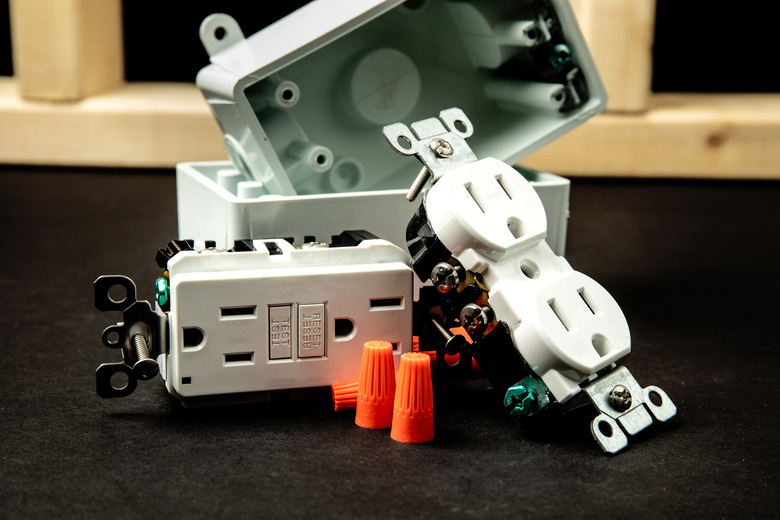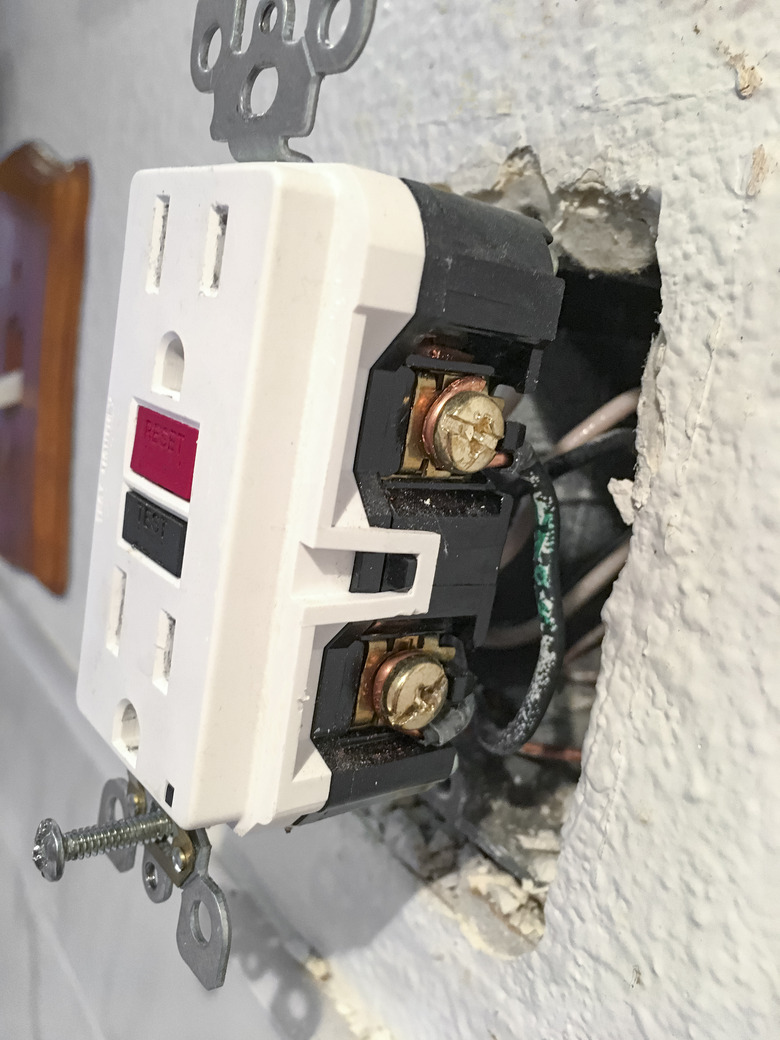What Is A GFCI, And Where Do I Need One?
We may receive a commission on purchases made from links.
The GFCI, or ground-fault circuit-interrupter, is an electrical safety device that can quite literally save your life. GFCIs have been required in homes in one form or another since 1968, yet most homeowners don't know what they are, or they know them only as the funny-looking outlets in their bathrooms and kitchens. GFCI outlets (also known as receptacles) are still one of the most common forms of GFCI devices, but newer homes increasingly use GFCI circuit breakers to offer similar protection to entire household circuits, not just outlets.
The life-saving capability of GFCIs should be enough to convince you to use them on any applicable wiring project, but if that doesn't sway you, perhaps the local law will. GFCI protection is required in many areas of the home any time the existing wiring is altered or updated. Even if you're not planning an electrical project, if you have an older home that lacks GFCI protection in wet areas (bathrooms, kitchens, outdoors, etc.), it's a really, really good idea to add it. This is arguably the single best way to improve electrical safety in your home, and it's also one of the easiest.
Tip
A GFCI (ground-fault circuit-interrupter) is a safety device that helps protect against electrical shock due to ground faults, such as short circuits or when water comes in contact with electricity. GFCI protection is required in kitchens, bathrooms, laundry rooms and other areas where moisture is commonly present.
What Does a GFCI Do?
What Does a GFCI Do?
In simple terms, a GFCI can sense imbalances in the flow of electricity and automatically shut off the power if it detects a problem — specifically, a ground fault. A ground fault occurs when electricity strays from its intended path (such as a wire) and tries to return to its source along an unintended path (such as a metal object, a pool of water or a human body). When James Bond kills his assailant by pushing him into a filled bathtub and tossing in a portable heater, he facilitates this electrocution by creating a ground fault. Mr. Bond is lucky that the heater wasn't plugged into a GFCI outlet, which would have saved the assassin's life (but where's the fun in that?).
Most likely, your home life is considerably less fraught with danger than 007's, but there are still plenty of shock hazards lurking about. Code rules about GFCI protection are designed to protect you in the areas where ground faults are most common, particularly areas where moisture or wet conditions are present. GFCIs can also protect against shock from faulty appliances, especially those with uninsulated metal cases or housings that can become energized if there's a short inside the appliance.
How a GFCI Works
How a GFCI Works
A GFCI contains a sensor that monitors the flow of electrical current between the hot and neutral conductors (wires) in an electrical circuit. Under normal conditions, electricity flows from the source (the service panel, or breaker box) to an outlet or other device along the hot wire, and it returns to the source along the neutral wire. If the sensor detects a minute change — as little as 0.004 amps (4 milliamps, or 4mA) — in the current flow, it shuts off the power to the portion of the circuit it is protecting. Such a change in flow indicates the electricity is going where it shouldn't.
How to Test a GFCI
How to Test a GFCI
GFCI sensors don't last forever, and they can fail to work properly. That's why GFCI outlets and circuit breakers have test and reset buttons on their faces. Testing is as easy as pressing the test button to make sure the GFCI clicks off and then pressing the reset button to restore power. The idea is that homeowners will follow the manufacturer's instructions and test all of their GFCIs once a month. However, if you're like most people, you've done this maybe once or, more likely, never.
Recognizing this reality, most GFCI devices now sold are self-testing and can shut themselves off if they fail their own test. Fortunately, this automatic testing is done without shutting off the outlet or circuit breaker, like you do with a manual test, and it's done much more frequently (as often as every 90 minutes to every few hours). For the record, manufacturers still recommend manual testing. Self-testing GFCIs feature indicator lights: green means all is well, and red means the device has failed a test or has reached its rated life span (and it's time to replace it).
Where GFCIs Are Required
Where GFCIs Are Required
Requirements for GFCI protection are prescribed by the local building or electrical code, and the local building authority has the final word on where you need GFCIs in your house. However, most local codes are based on the National Electrical Code (NEC) recommendations. The NEC is updated every three years and was last revised in 2020.
The 2020 NEC requires GFCI protection in the following areas:
- Kitchens
- Bathrooms
- Laundry rooms
- Basements
- Outdoors
- Garages
- Crawl spaces
- Pool and spa areas
In addition to those in general areas, GFCI requirements can apply to specific fixtures or appliances. For example, sump pumps, whirlpools, jetted tubs and hot tubs all need GFCI protection. Rules can also apply to different elements in a given area. In the kitchen, most outlets must be GFCI-protected but not kitchen lighting. In a crawl space, all outlets and lighting must have GFCI protection.
The 2020 NEC expanded GFCI protection in a few key areas. Previously, GFCI protection applied only to standard-voltage (120-volt) circuits. This meant that electric ranges and dryers, which run on 240 volts, were exempt. Per the 2020 NEC, GFCI protection applies to circuits up to 250 volts, so now outlets for dryers must be GFCI-protected, and outlets for ranges need GFCI protection if they're within 6 feet of a sink. Dishwashers must also be GFCI-protected per the 2020 NEC. Finally, GFCI protection in basements was expanded to include all basements, not just unfinished basements, as was the case with previous requirements.
GFCI Outlets vs. GFCI Circuit Breakers
GFCI Outlets vs. GFCI Circuit Breakers
For many years, GFCI protection in homes was provided by GFCI outlets (receptacles), and electricians and homebuilders simply installed GFCI outlets wherever they were required. GFCI outlets can be wired in one of two ways. With single-location wiring, a GFCI outlet protects only itself. With multiple-location wiring, a GFCI outlet protects itself and all outlets and other devices beyond (or "downstream" of) the GFCI outlet on the same circuit; it does not provide protection between the GFCI and the service panel.
Multiple-location wiring is used when multiple outlets on a single circuit need GFCI protection, such as with kitchen countertop outlets or in bathrooms that have more than one outlet. This configuration allows you to install a single GFCI outlet (which costs about $15 to $25) to protect multiple standard outlets (which can cost less than $2 each) on the same circuit. If your kitchen counter area has one GFCI outlet and several others that look normal, chances are the GFCI is protecting all of them.
Outlets wired for single-location or multiple-location protection have their place and are acceptable ways to meet GFCI requirements, but with new home builds and wiring upgrades, most GFCI protection is provided by GFCI circuit breakers. A GFCI breaker protects every device on an entire circuit, including all outlets, switches, lights, appliances, wiring and other equipment. GFCI breakers cost many times more than standard breakers (about $40 for a 120-volt GFCI breaker), but they save you the high cost of GFCI outlets. Today's GFCI breakers are self-testing (in addition to having manual test buttons), just like newer GFCI outlets. In special cases, such as with electric dryers, a GFCI breaker is required because there's no such thing as a 240-volt GFCI dryer outlet (at least not yet).
Installing a GFCI
Installing a GFCI
GFCI circuit breakers and outlets install similarly to their standard counterparts and are designed to fit into standard electrical boxes and service panel breaker slots. This means you can swap out an old standard breaker or outlet with a GFCI model. However, there are some important differences with GFCI installation.
When installing a standard 120-volt circuit breaker, the circuit's hot wire (typically black) connects to the single terminal on the breaker itself, and the circuit's neutral wire (typically white) connects to the neutral terminal bar on the service panel. The circuit ground wire connects to the panel's grounding bar. By contrast, a GFCI breaker has terminals for both the circuit hot wire and the circuit neutral wire, so both of these wires connect to the breaker. It also has its own neutral wire (a white coiled wire often called a pigtail); this connects to the neutral terminal bar on the panel. The circuit ground connects to the grounding bar, as with a standard breaker installation.
A standard duplex outlet (with two sets of plug slots) has two hot and two neutral terminals. For most installations, the two hots are interchangeable, and you can connect each hot wire to either hot terminal; the same is true of the neutrals. With a GFCI outlet, none of the terminals are interchangeable. One hot and one neutral are labeled "line," and the other hot and neutral are labeled "load." You use only the line terminals for single-location wiring, and you use both the line and load terminals for multiple-location wiring.
GFCI outlets also have a ground screw (as do standard outlets) where you connect the circuit ground wire(s) if there are any. One nice thing about a GFCI is that you don't need a ground wire to provide GFCI protection. In fact, replacing older ungrounded outlets with GFCIs can improve safety. However, it's important to note that GFCIs do not provide a ground. If you install a GFCI on a circuit with no ground, you should place a sticker on the outlet's cover plate that reads "no equipment ground" (or similar wording). You'll find these stickers inside the box with a new GFCI outlet.
GFCIs and AFCIs
GFCIs and AFCIs
Now that you know a little more about GFCIs, it will help to have an introduction to AFCIs, or arc-fault circuit-interrupters. AFCIs came around after GFCIs, but they're now required in more places around the home than GFCIs. Generally speaking, AFCI protection is required everywhere except bathrooms, garages, outdoors and in crawl spaces and unfinished basements (it is required in finished basements). AFCI devices are found on outlets and circuit breakers, and they install just like their GFCI counterparts. AFCIs protect against arc-faults, which are common causes of circuit overloads and electrical fires. Together, GFCIs and AFCIs have made modern wiring systems less likely to shock you or start your house on fire. It's hard to argue with that.
You get extra credit if you've surmised that some areas of the home need both GFCI and AFCI protection. These are most notably kitchens, finished basements and laundry rooms. The standard practice today for meeting this dual-protection requirement is to install a dual-function GFCI/AFCI circuit breaker. These provide both GFCI and AFCI protection to the entire circuit. They're self-testing, they install just like standard GFCI or AFCI breakers and they cost only about $8 or $10 more. If you're out shopping for a dual-function breaker, don't be confused by the term "combination," which simply indicates that the device protects against two different categories of arc faults. Virtually all AFCIs are combination type, and some (not all) are labeled "CAFCI." Only a "dual-function" breaker provides both GFCI and AFCI protection.
References
- IAEI Magazine: Ground-Fault Circuit Interrupter (GFCI) Protection
- SafeElectricity.org: Ground Fault Circuit Interrupters (GFCIs)
- National Fire Protection Association: Three Key Changes in the 2020 National Electrical Code That Help Make Kitchens Safer for Families
- YouTube: Leviton – Introducing the SmartlockPro® Self-Test GFCI Receptacle from Leviton
- YouTube: Square D by Schneider Electric – NEC 2020: Residential – Ground Fault Current Interrupters Requirements


